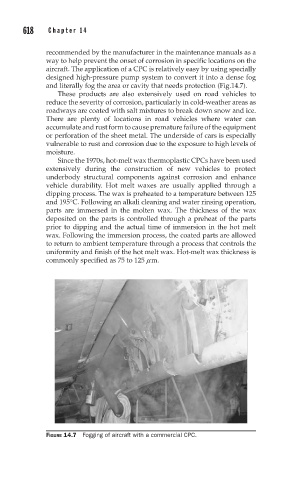Page 664 - Corrosion Engineering Principles and Practice
P. 664
618 C h a p t e r 1 4 P r o t e c t i v e C o a t i n g s 619
recommended by the manufacturer in the maintenance manuals as a
way to help prevent the onset of corrosion in specific locations on the
aircraft. The application of a CPC is relatively easy by using specially
designed high-pressure pump system to convert it into a dense fog
and literally fog the area or cavity that needs protection (Fig.14.7).
These products are also extensively used on road vehicles to
reduce the severity of corrosion, particularly in cold-weather areas as
roadways are coated with salt mixtures to break down snow and ice.
There are plenty of locations in road vehicles where water can
accumulate and rust form to cause premature failure of the equipment
or perforation of the sheet metal. The underside of cars is especially
vulnerable to rust and corrosion due to the exposure to high levels of
moisture.
Since the 1970s, hot-melt wax thermoplastic CPCs have been used
extensively during the construction of new vehicles to protect
underbody structural components against corrosion and enhance
vehicle durability. Hot melt waxes are usually applied through a
dipping process. The wax is preheated to a temperature between 125
and 195°C. Following an alkali cleaning and water rinsing operation,
parts are immersed in the molten wax. The thickness of the wax
deposited on the parts is controlled through a preheat of the parts
prior to dipping and the actual time of immersion in the hot melt
wax. Following the immersion process, the coated parts are allowed
to return to ambient temperature through a process that controls the
uniformity and finish of the hot melt wax. Hot-melt wax thickness is
commonly specified as 75 to 125 m m.
FIGURE 14.7 Fogging of aircraft with a commercial CPC.

